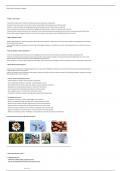Class notes
Origins of Life: Unraveling the Biology of Existence ( BI100)
- Course
- BI100
- Institution
- Wilfrid Laurier University (WLU )
Notes include: Flowcharts, images and summaries, first year biology ( BI100). Dive into the summary of biology and explore the defining characteristics of life, the debate on the classification of viruses, and the evolutionary milestones that shaped our understanding of existence. These notes i...
[Show more]



